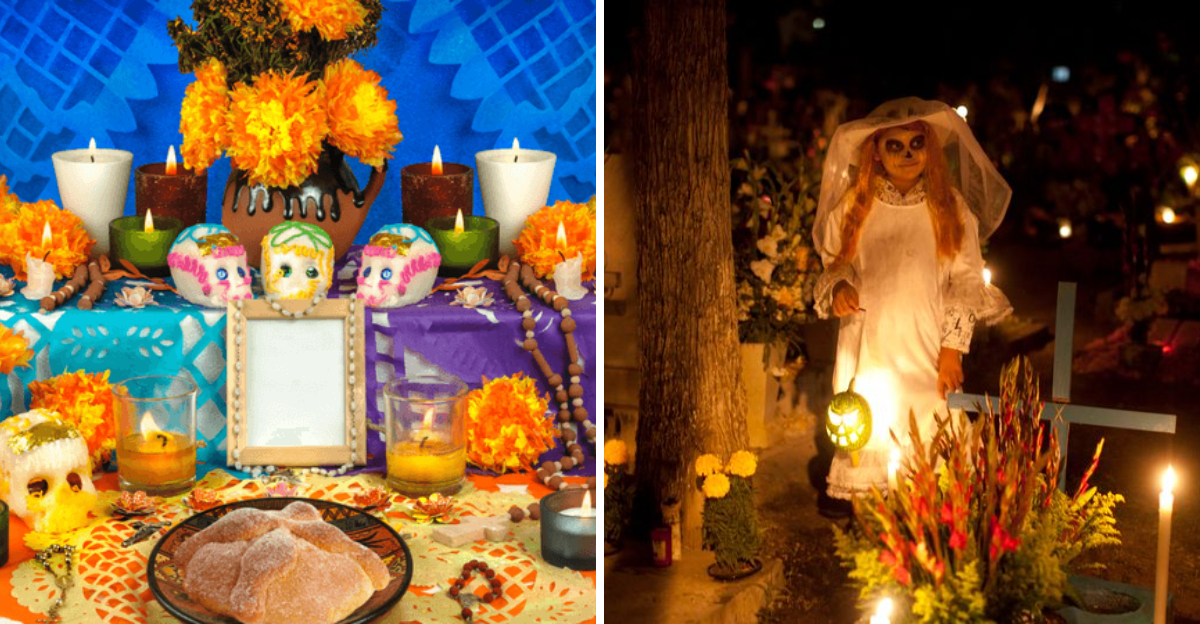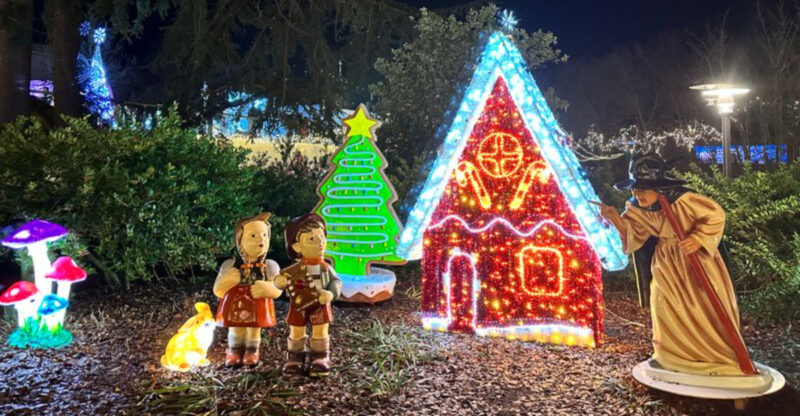Intriguing Insights Into New Mexico’s Day Of The Dead Traditions

New Mexico’s Day of the Dead celebrations blend ancient indigenous customs with Spanish Catholic influences, creating a unique cultural tapestry unlike anywhere else in America.
Families gather to honor departed loved ones through vibrant altars, special foods, and community events that bridge the gap between life and death.
These traditions have evolved over centuries, reflecting the state’s rich multicultural heritage while maintaining the core belief that death is not an end but a transition worth celebrating.
1. Marigold Pathways Guide Spirits Home
Bright orange marigold petals create stunning pathways from cemeteries to family homes during New Mexico’s Day of the Dead celebrations. These vibrant flowers, known as ‘cempasúchil’ or ‘flor de muerto,’ aren’t just beautiful decorations they serve a sacred purpose.
The strong scent and radiant color guide spirits back to their families for the annual reunion. Many New Mexican families spend days collecting and stringing these blossoms into elaborate arrangements.
This tradition blends Aztec beliefs about marigolds as symbols of death with Catholic customs of decorating graves. When the sun sets and candles are lit, these golden pathways seem to glow with otherworldly light, creating a magical atmosphere that connects two worlds.
2. Sugar Skulls With Regional Flair
New Mexican sugar skulls feature distinctive regional designs that set them apart from other Day of the Dead celebrations. While the basic concept originated in Mexico, local artisans incorporate Pueblo and Hispanic artistic elements, creating a unique fusion found only in this region.
Families often gather to make these sweet memorials together, using traditional clay molds passed down through generations. The decorating process becomes a storytelling opportunity as grandparents share memories of those being honored.
Unlike mass-produced versions, authentic New Mexican calaveras might include turquoise-colored accents, Zia symbols, or designs inspired by native pottery patterns. These edible artworks represent both the sweetness of life and the inevitable reality of death.
3. Midnight Cemetery Picnics
Did you know some New Mexican families hold midnight picnics in cemeteries during Day of the Dead? This intimate tradition involves bringing the deceased’s favorite foods, drinks, and even music to share at their graveside well after dark.
Graves transform into candlelit dining spaces where families laugh, cry, and reconnect with their ancestors’ spirits. The atmosphere isn’t spooky it’s surprisingly joyful and comforting.
Unlike daytime cemetery visits, these nighttime gatherings feel more private and spiritual. The darkness creates a sense that the veil between worlds has truly thinned. Many participants describe feeling their loved ones’ presence most strongly during these moonlit meals, making the experience deeply meaningful rather than mournful.
4. Pan de Muerto With Piñon Nuts
New Mexico’s version of pan de muerto stands apart from other regional variations thanks to one special ingredient: piñon nuts. These tiny pine nuts, harvested from local forests, give the traditional sweet bread a distinctly earthy, resinous flavor that connects the bread to the landscape.
Bakers shape the dough into round loaves with bone-like decorations on top, representing the circle of life and the departed. Many family recipes include anise seed and orange blossom water, creating a fragrant treat that fills homes with mouthwatering aromas.
When sharing this bread, New Mexicans often leave a piece on the ofrenda (altar) while enjoying the rest together. The symbolic act of breaking bread with both the living and the dead reinforces family bonds across generations.
5. Personal Items Transform Altars
Personal possessions breathe life into New Mexican Day of the Dead altars, transforming them from generic displays into deeply meaningful tributes. Families carefully select items that capture their loved ones’ essence a grandfather’s weathered fishing hat, a mother’s favorite lipstick, or a child’s beloved toy.
These objects serve as powerful memory triggers, often provoking spontaneous storytelling when visitors notice them. Many New Mexican families believe these personal items help attract the spirits back home by surrounding them with familiar comforts.
Unlike the formal religious elements on the altar, these everyday objects create intimate connections between generations. A pair of reading glasses or a handwritten recipe card can evoke stronger emotional responses than any traditional decoration, making each altar as unique as the person it honors.
6. Indigenous Symbols Blend With Catholic Imagery
Throughout New Mexico, Day of the Dead celebrations showcase a fascinating visual blend of indigenous symbols and Catholic imagery that reflects the state’s complex cultural history. Ancient Pueblo symbols like the stepped cloud and the sacred corn maiden often appear alongside crosses and saints on altars and decorations.
This spiritual fusion isn’t random it represents centuries of cultural negotiation and adaptation. Many families incorporate traditional medicine wheels, kachina-inspired imagery, or native pottery designs into otherwise Catholic-looking displays.
The result is a uniquely New Mexican aesthetic that honors both ancestral indigenous beliefs and Spanish colonial influences. Rather than choosing between traditions, local communities have created celebrations that embrace multiple spiritual pathways, allowing families to connect with their ancestors through whichever symbols resonate most deeply.
7. Community Bread Ovens Center Celebrations
Historic adobe hornos (outdoor bread ovens) become bustling community hubs during New Mexico’s Day of the Dead celebrations. These beehive-shaped ovens, a legacy of Spanish colonial influence, bring neighborhoods together for communal baking sessions that produce enough bread to feed both the living and the dead.
Families take turns using these shared ovens, some of which have been in continuous use for centuries. The oldest community members often oversee the baking, ensuring traditional techniques aren’t lost to newer generations.
More than just cooking equipment, these hornos represent the communal spirit of mourning and remembrance. The act of preparing food together creates a support network for grieving families while producing the pan de muerto that will grace altars throughout the village, connecting everyone through shared traditions and flavors.
8. Luminaria-Lined Processions After Dark
When darkness falls across New Mexico during Day of the Dead, communities light thousands of luminarias small paper lanterns with candles inside creating glowing pathways for both the living and the dead. These humble lights transform ordinary streets into magical corridors that guide evening processions between churches, cemeteries, and public plazas.
Unlike electric lights, these handmade paper lanterns cast a warm, flickering glow that dances with the movement of participants. Many New Mexican families prepare these lights together, filling paper bags with sand before carefully placing candles inside a meditative practice that connects generations.
The resulting nighttime processions feel both solemn and joyful as community members follow these illuminated paths together. The soft light creates a liminal atmosphere where participants often report feeling closer to their ancestors’ spirits.
9. Special Foods Reconnect Families With Ancestors
Kitchens across New Mexico buzz with activity during Day of the Dead as families recreate departed loved ones’ signature recipes, believing food creates powerful connections between worlds. Grandmothers’ chile recipes, uncles’ favorite bizcochitos cookies, or a father’s special posole stew become more than meals they’re edible memories that summon spirits through familiar tastes and smells.
Many families still use heirloom cooking tools like molcajetes (stone mortars) or cast iron pans that belonged to their ancestors, adding another layer of connection. The preparation becomes as important as the finished dishes.
When these foods are placed on ofrendas or shared among family members, conversations naturally turn to stories about the departed. Through these culinary traditions, even family members who never met the deceased can experience something of their presence through flavors passed down through generations.
10. Storytelling Circles Preserve Family Histories
Gathering in circles around crackling piñon wood fires, New Mexican families share stories about their ancestors during Day of the Dead, ensuring family histories survive through oral tradition. These storytelling sessions often reveal surprising details about departed relatives that might otherwise be forgotten their childhood adventures, romances, struggles, and triumphs.
Older family members typically lead these circles, but everyone participates, creating a living web of memories. Children are encouraged to ask questions about relatives they never met, helping them develop personal connections to their family’s past.
Unlike written histories, these dynamic storytelling traditions adapt over time while preserving essential truths about who came before. The firelight creates an intimate atmosphere where laughter and tears flow freely, and many participants describe feeling their ancestors’ presence most strongly during these shared narrative moments.
11. Hand-Carved Santos Figures Guard Altars
Intricately carved wooden santos (saint figures) stand watch over many New Mexican Day of the Dead altars, continuing a folk art tradition that dates back to Spanish colonial times. These distinctive figures, often carved from local cottonwood or pine, represent both Catholic saints and folk protectors who guard the deceased on their spiritual journey.
Unlike mass-produced religious items, these handmade santos carry the energy of their creators. Many New Mexican families commission new santos to honor recently departed loved ones, working with local santeros (saint-makers) who incorporate personal details into the carvings.
The most treasured santos have been passed down through generations, accumulating family stories and spiritual significance with each passing year. Their weathered faces and detailed expressions create a powerful sense of watchful protection over both the altar and the family gathering to remember their dead.
12. Desert Plants Create Natural Connections
Native desert plants play crucial roles in New Mexico’s Day of the Dead celebrations, creating natural bridges between the living landscape and spiritual remembrance. Yucca flowers, piñon branches, sage bundles, and juniper berries aren’t just decorative elements they’re considered spiritual tools with specific purposes in honoring the dead.
Many families collect these plants themselves during special gathering expeditions before the holiday begins. The process of harvesting becomes a ritual that connects participants to both the land and their ancestors who used these same plants.
When arranged on altars or used in cleansing ceremonies, these native plants bring the essence of New Mexico’s landscape into the celebration. Their distinctive aromas the sharp scent of sage, the sweetness of piñon create olfactory connections to place that help ground the spiritual experience in the physical world where ancestors once walked.
13. Children’s Participation Ensures Tradition Continues
Children take center stage in many aspects of New Mexico’s Day of the Dead celebrations, ensuring these ancient traditions continue for generations to come. Unlike Halloween, which separates children from death concepts, this holiday actively involves young people in constructing altars, preparing special foods, and learning about family members who died before they were born.
Schools throughout New Mexico incorporate altar-making and sugar skull decorating into their curricula during late October. This educational approach helps children develop healthy relationships with mortality while strengthening their cultural identity.
Many families create special roles for their youngest members, like having children place marigold petals or carry photographs in processions. Through these meaningful responsibilities, children learn that remembering the dead isn’t frightening but rather a natural extension of family love that transcends physical boundaries between worlds.






